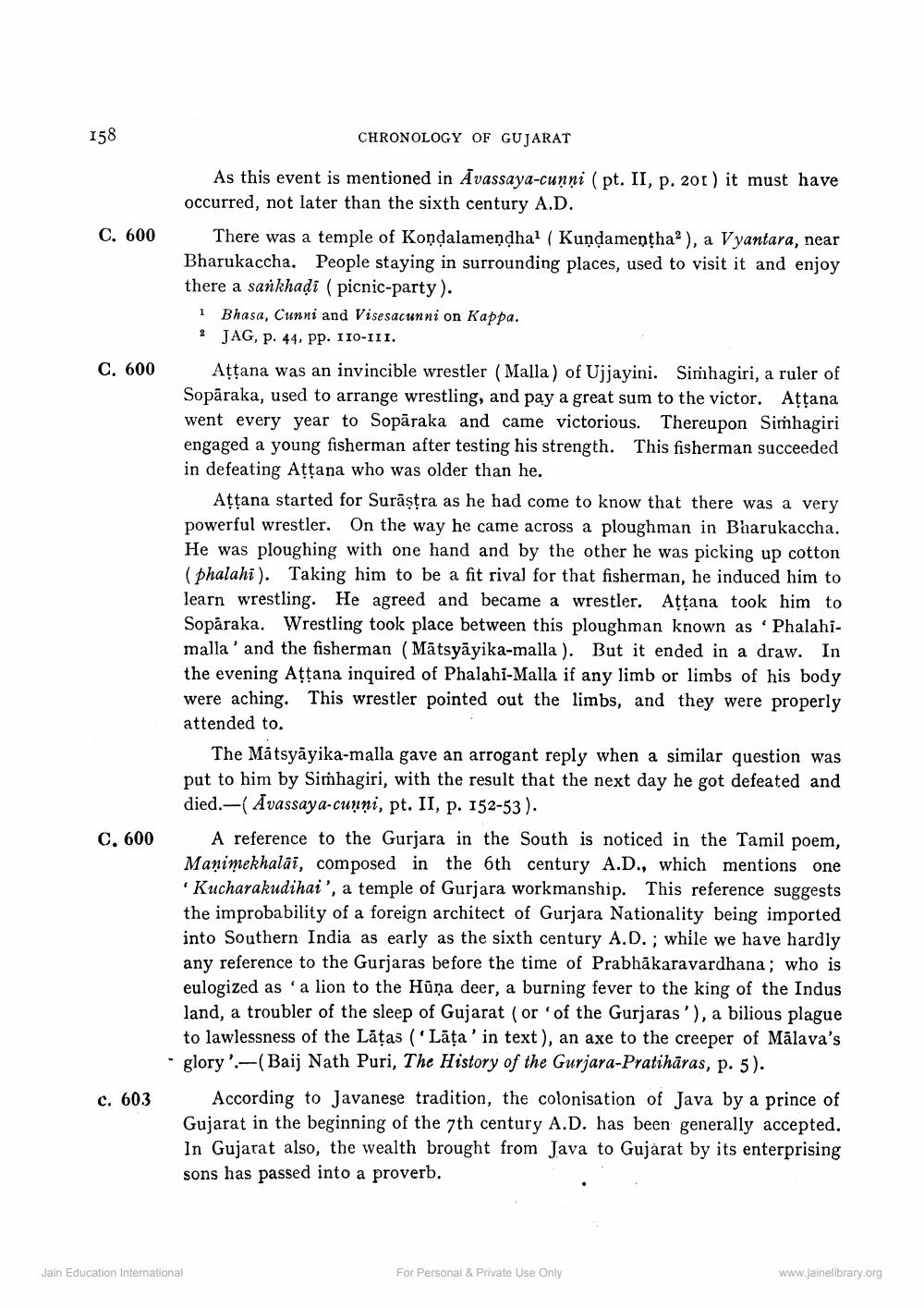________________
158
CHRONOLOGY OF GUJARAT
C. 600
C. 600
As this event is mentioned in Āvassaya-cunni (pt. II, p. 201) it must have occurred, not later than the sixth century A.D.
There was a temple of Kondalamendhal (Kundamentha"), a Vyantara, near Bharukaccha. People staying in surrounding places, used to visit it and enjoy there a sankhadi (picnic-party).
i Bhasa, Cunni and Visesacunni on Kappa. ? JAG, P. 44, pp. 110-III.
Attana was an invincible wrestler (Malla) of Ujjayini. Simhagiri, a ruler of Sopāraka, used to arrange wrestling, and pay a great sum to the victor. Astana went every year to Sopāsaka and came victorious. Thereupon Simhagiri engaged a young fisherman after testing his strength. This fisherman succeeded in defeating Attana who was older than he.
Attana started for Surāṣtra as he had come to know that there was a very powerful wrestler. On the way he came across a ploughman in Bharukaccha. He was ploughing with one hand and by the other he was picking up cotton (phalahi). Taking him to be a fit rival for that fisherman, he induced him to learn wrestling. He agreed and became a wrestler. Aţtana took him to Sopäraka. Wrestling took place between this ploughman known as Phalahimalla' and the fisherman (Mātsyāyika-malla ). But it ended in a draw. In the evening Attana inquired of Phalahi-Malla if any limb or limbs of his body were aching. This wrestler pointed out the limbs, and they were properly attended to.
The Mätsyāyika-malla gave an arrogant reply when a similar question was put to him by Simhagiri, with the result that the next day he got defeated and died.-( Āvassaya-cunni, pt. II, p. 152-53).
A reference to the Gurjara in the South is noticed in the Tamil poem, Manimekhalâi, composed in the 6th century A.D., which mentions one * Kucharakudihai', a temple of Gurjara workmanship. This reference suggests the improbability of a foreign architect of Gurjara Nationality being imported into Southern India as early as the sixth century A.D. ; while we have hardly any reference to the Gurjaras before the time of Prabhākaravardhana; who is eulogized as 'a lion to the Hūņa deer, a burning fever to the king of the Indus land, a troubler of the sleep of Gujarat (or of the Gurjaras'), a bilious plague to lawlessness of the Lāțas ("Lāța ' in text), an axe to the creeper of Mālava's glory':-(Baij Nath Puri, The History of the Gurjara-Pratihāras, p. 5).
According to Javanese tradition, the colonisation of Java by a prince of Gujarat in the beginning of the 7th century A.D. has been generally accepted. In Gujarat also, the wealth brought from Java to Gujarat by its enterprising sons has passed into a proverb.
C. 600
c. 603
Jain Education International
For Personal & Private Use Only
www.jainelibrary.org




